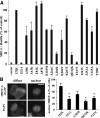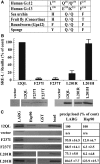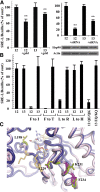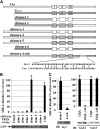Gα12 structural determinants of Hsp90 interaction are necessary for serum response element-mediated transcriptional activation
- PMID: 24435554
- PMCID: PMC3965892
- DOI: 10.1124/mol.113.088443
Gα12 structural determinants of Hsp90 interaction are necessary for serum response element-mediated transcriptional activation
Abstract
The G12/13 class of heterotrimeric G proteins, comprising the α-subunits Gα12 and Gα13, regulates multiple aspects of cellular behavior, including proliferation and cytoskeletal rearrangements. Although guanine nucleotide exchange factors for the monomeric G protein Rho (RhoGEFs) are well characterized as effectors of this G protein class, a variety of other downstream targets has been reported. To identify Gα12 determinants that mediate specific protein interactions, we used a structural and evolutionary comparison between the G12/13, Gs, Gi, and Gq classes to identify "class-distinctive" residues in Gα12 and Gα13. Mutation of these residues in Gα12 to their deduced ancestral forms revealed a subset necessary for activation of serum response element (SRE)-mediated transcription, a G12/13-stimulated pathway implicated in cell proliferative signaling. Unexpectedly, this subset of Gα12 mutants showed impaired binding to heat-shock protein 90 (Hsp90) while retaining binding to RhoGEFs. Corresponding mutants of Gα13 exhibited robust SRE activation, suggesting a Gα12-specific mechanism, and inhibition of Hsp90 by geldanamycin or small interfering RNA-mediated lowering of Hsp90 levels resulted in greater downregulation of Gα12 than Gα13 signaling in SRE activation experiments. Furthermore, the Drosophila G12/13 homolog Concertina was unable to signal to SRE in mammalian cells, and Gα12:Concertina chimeras revealed Gα12-specific determinants of SRE activation within the switch regions and a C-terminal region. These findings identify Gα12 determinants of SRE activation, implicate Gα12:Hsp90 interaction in this signaling mechanism, and illuminate structural features that arose during evolution of Gα12 and Gα13 to allow bifurcated mechanisms of signaling to a common cell proliferative pathway.
Figures







Similar articles
-
Divergent C-terminal motifs in Gα12 and Gα13 provide distinct mechanisms of effector binding and SRF activation.Cell Signal. 2020 Aug;72:109653. doi: 10.1016/j.cellsig.2020.109653. Epub 2020 Apr 21. Cell Signal. 2020. PMID: 32330601
-
Distinct regions of Galpha13 participate in its regulatory interactions with RGS homology domain-containing RhoGEFs.Cell Signal. 2007 Aug;19(8):1681-9. doi: 10.1016/j.cellsig.2007.03.004. Epub 2007 Mar 15. Cell Signal. 2007. PMID: 17449226
-
Determinants at the N- and C-termini of Gα12 required for activation of Rho-mediated signaling.J Mol Signal. 2013 Mar 25;8(1):3. doi: 10.1186/1750-2187-8-3. J Mol Signal. 2013. PMID: 23531275 Free PMC article.
-
Heterotrimeric Gα12/13 proteins in kidney injury and disease.Am J Physiol Renal Physiol. 2020 Mar 1;318(3):F660-F672. doi: 10.1152/ajprenal.00453.2019. Epub 2020 Jan 27. Am J Physiol Renal Physiol. 2020. PMID: 31984793 Review.
-
Regulation and physiological functions of G12/13-mediated signaling pathways.Neurosignals. 2009;17(1):55-70. doi: 10.1159/000186690. Epub 2009 Feb 12. Neurosignals. 2009. PMID: 19212140 Free PMC article. Review.
Cited by
-
Cellular mechanisms of the 5-HT7 receptor-mediated signaling.Front Behav Neurosci. 2014 Oct 1;8:306. doi: 10.3389/fnbeh.2014.00306. eCollection 2014. Front Behav Neurosci. 2014. PMID: 25324743 Free PMC article. Review.
-
Gα12 and Gα13: Versatility in Physiology and Pathology.Front Cell Dev Biol. 2022 Feb 14;10:809425. doi: 10.3389/fcell.2022.809425. eCollection 2022. Front Cell Dev Biol. 2022. PMID: 35237598 Free PMC article. Review.
-
Can Serotonin 7 Receptors Be a Treatment Target for Noncentral Diseases?Eurasian J Med. 2023 Dec;55(1):S49-S54. doi: 10.5152/eurasianjmed.2023.23303. Eurasian J Med. 2023. PMID: 39128036 Free PMC article.
-
Breast cancer cell invasion mediated by Gα12 signaling involves expression of interleukins-6 and -8, and matrix metalloproteinase-2.J Mol Signal. 2014 Jun 17;9:6. doi: 10.1186/1750-2187-9-6. eCollection 2014. J Mol Signal. 2014. PMID: 24976858 Free PMC article.
-
A Gα12-specific Binding Domain in AKAP-Lbc and p114RhoGEF.J Mol Signal. 2016 Sep 9;11:3. doi: 10.5334/1750-2187-11-3. J Mol Signal. 2016. PMID: 31051012 Free PMC article.
References
-
- Adarichev VA, Vaiskunaite R, Niu J, Balyasnikova IV, Voyno-Yasenetskaya TA. (2003) Gα13-mediated transformation and apoptosis are permissively dependent on basal ERK activity. Am J Physiol Cell Physiol 285:C922–C934 - PubMed
-
- Barrett K, Leptin M, Settleman J. (1997) The Rho GTPase and a putative RhoGEF mediate a signaling pathway for the cell shape changes in Drosophila gastrulation. Cell 91:905–915 - PubMed
-
- Bhattacharyya R, Wedegaertner PB. (2000) Galpha 13 requires palmitoylation for plasma membrane localization, Rho-dependent signaling, and promotion of p115-RhoGEF membrane binding. J Biol Chem 275:14992–14999 - PubMed
-
- Cabrera-Vera TM, Vanhauwe J, Thomas TO, Medkova M, Preininger A, Mazzoni MR, Hamm HE. (2003) Insights into G protein structure, function, and regulation. Endocr Rev 24:765–781 - PubMed
Publication types
MeSH terms
Substances
Grants and funding
LinkOut - more resources
Full Text Sources
Other Literature Sources
Molecular Biology Databases

